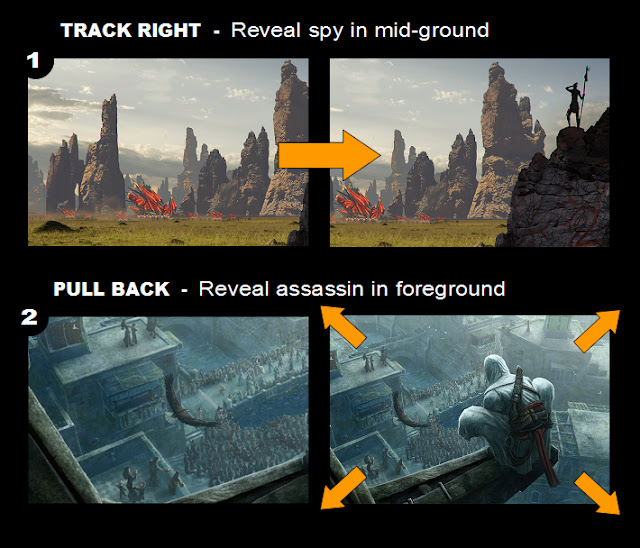A Motion Reveal is a camera movement that discloses a secret image to the audience. It could be a character in hiding, a concealed weapon or a vital clue. The reveal adds context to a scene, raising audience awareness and heightening the emotional experience.
.
A pan, tilt, jib or track can all be employed to reveal a hidden subject. Start your shot with the undisclosed image out of frame. As the scene plays out, a beat will present itself. At this moment adjust the camera position to bring the concealed image into frame. For example:
THE EFFECT
.
.
.
A motion reveal acts as an aside to the audience, offering them a private insight. The reveal can be used in one of two ways. If the audience are aware of the image but the characters aren't, suspense is created as the audience begin to fret over what may happen to the unwitting protagonist. However, if the characters are aware of the image, but we the audience are ignorant, then the reveal induces surprise when disclosed to us.
EXAMPLE SCENES
.
The Ninth Gate (Suspense: The characters are unaware of a hidden image)
Two book dealers (Dean and Bernie) are studying a demonic text in the basement of their shop. As they discuss the thrill of such a rare tome, the camera drifts to the right revealing someone spying upon them through a window. This clandestine p.o.v. is for the audience eyes only, letting us in on a possible threat Dean and Bernie are in. This 'reveal' helps to provoke both intrigue and suspense.
Cabaret (Surprise: The audience are unaware of a concealed image)
Two friends (Brian and Max) hear the voice of a young man singing in a German garden. They watch as the boy strikes passion and pride in the hearts of his listeners. We the audience are also caught by this fervent song which is sung with great devotion. Then the motion reveal takes effect; the camera slowly jibs down to reveal a Nazi emblem on the uniform of this Nazi youth.
If we were shown the swatchka first, we would have formed a prejudgment on the situation. Instead, we were momentarily duped into an innocent p.o.v. allowing us to invest more into the boys patriotic song (much as the German people would have). In this example, the clever use of the motion reveal offers us an insight into how persuasive Nazi propaganda was (from a non judgmental viewpoint).
If we were shown the swatchka first, we would have formed a prejudgment on the situation. Instead, we were momentarily duped into an innocent p.o.v. allowing us to invest more into the boys patriotic song (much as the German people would have). In this example, the clever use of the motion reveal offers us an insight into how persuasive Nazi propaganda was (from a non judgmental viewpoint).
OTHER EXAMPLES
Kill Bill - Vol 1: In this scene, O-Ren Ishii sends her bodyguard to investigate a suspicious noise from outside. The Bride (Uma Thurman), who was literally just behind the door, now seems to have completely disappeared. As the bodyguard scans the room, the camera jibs down and tilts up revealing an unexpected view of the Bride hanging from the rafters. Immediately a sense of shock and suspense is evoked from the audience.
Forest Gump: In the end of this clip there is a surprise reveal which adds a humorous context to the scene. What we thought was a private moment between Jenny and Forest turns out to have been a shared one. The characters knew there was someone else in the room the whole time. We, the audience, only become aware of it when the camera jibs down to reveal a horrified room mate whose bathrobe has been 'soiled'.

